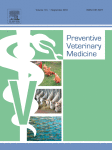Ver ítem
- xmlui.general.dspace_homeCentros Regionales y EEAsCentro Regional Santa FeEEA RafaelaArtículos científicosxmlui.ArtifactBrowser.ItemViewer.trail
- Inicio
- Centros Regionales y EEAs
- Centro Regional Santa Fe
- EEA Rafaela
- Artículos científicos
- Ver ítem
Comprehensive evaluation and implementation of improvement actions in bovine abattoirs to reduce pathogens exposure
Resumen
The slaughter process plays an important role in animal welfare, meat quality, safety and public health through the meat production chain. In this study, we performed a three-stage evaluation: I) comprehensive evaluation, II) implementation of improvement actions and III) verification of the success of the actions implemented in three abattoirs from Argentina during 2016-2018. Risk was estimated using two checklists, quantified on a 1–100 scale and
[ver mas...]
The slaughter process plays an important role in animal welfare, meat quality, safety and public health through the meat production chain. In this study, we performed a three-stage evaluation: I) comprehensive evaluation, II) implementation of improvement actions and III) verification of the success of the actions implemented in three abattoirs from Argentina during 2016-2018. Risk was estimated using two checklists, quantified on a 1–100 scale and classified as high (1–40), moderate (41–70) and low (71–100). In stages I and III, Salmonella spp., E. coli O157:H7 and non-O157 STEC were detected and isolated in samples from carcasses (n = 252), the environment (n = 252); head meat (n = 21) and viscera washing and chilling water (n = 105). Carcass samples were analyzed for mesophilic aerobic organisms, coliforms and E. coli enumeration. Of 201 water samples taken, 42.0–75.6 % were non-potable quality. After the implementation of improvement actions in stage II (building, processes, systems for water purification and training), the estimation of risk of contamination was reduced from high to moderate in all three abattoirs, the count of indicator microorganisms decreased in two abattoirs, and the presence of pathogens significantly decreased. Salmonella spp. was not isolated from any of the samples collected in two abattoirs. Isolation of E. coli O157:H7 decreased in carcass and was not isolated from viscera washing and chilling water. Isolation of non-O157 STEC decreased in carcass but not in environmental samples. Finally, 75.0–95.0 % of water samples were of potable quality. Although this was only the first step in the process of change and improvement of abattoirs, the assessment of the situation and the proposal of solutions to correct deviations in a joint effort with the health authorities helped to implement a work model for enhancing food safety before meat reaches consumers.
[Cerrar]

Autor
Costa, Magdalena;
Pracca, Gabriela;
Sucari, Adriana;
Galli, Lucía;
Ibargoyen, José;
Gentiluomo, Jimena;
Brusa, Victoria;
Martinez Zugazua, Matías;
Figueroa, Yamila;
Londero, Alejandra;
Rogé, Ariel Diego;
Silva, Hernán;
Ploeg, Claudia A. Van Der;
Signorini, Marcelo;
Oteiza, Juan Martín;
Leotta, Gerardo Anibal;
Fuente
Preventive Veterinary Medicine 176 : 104933 (March 2020)
Fecha
2020-03
Editorial
Elsevier
ISSN
0167-5877
1873-1716
1873-1716
Formato
pdf
Tipo de documento
artículo
Palabras Claves
Derechos de acceso
Restringido
 Excepto donde se diga explicitamente, este item se publica bajo la siguiente descripción: Creative Commons Attribution-NonCommercial-ShareAlike 2.5 Unported (CC BY-NC-SA 2.5)
Excepto donde se diga explicitamente, este item se publica bajo la siguiente descripción: Creative Commons Attribution-NonCommercial-ShareAlike 2.5 Unported (CC BY-NC-SA 2.5)

